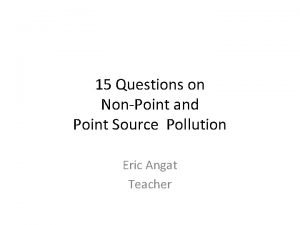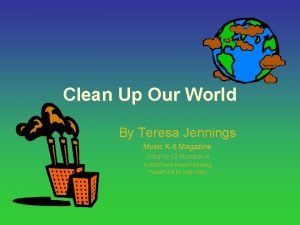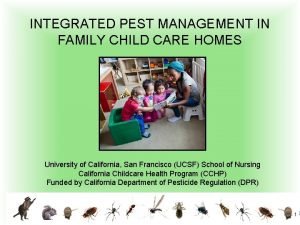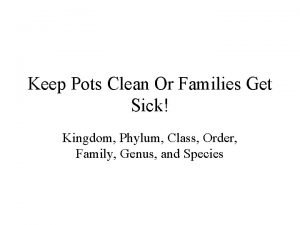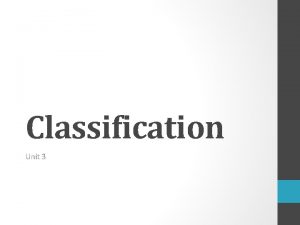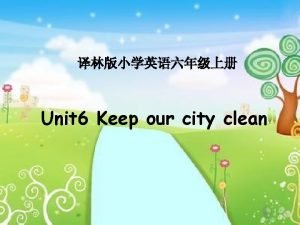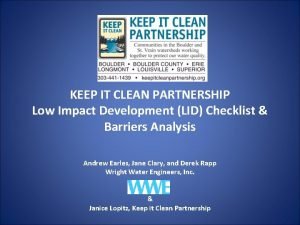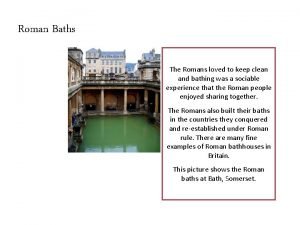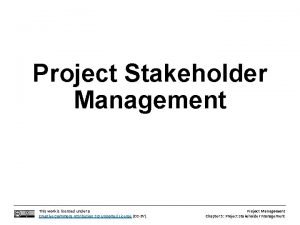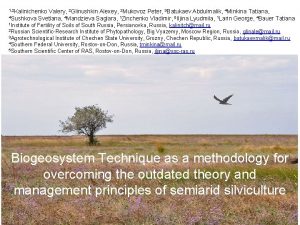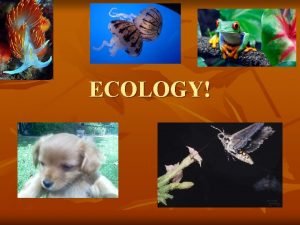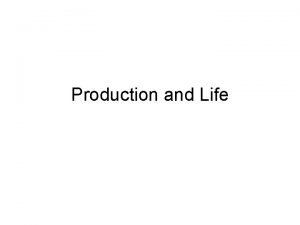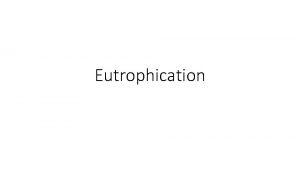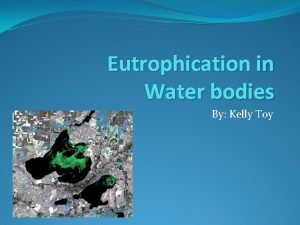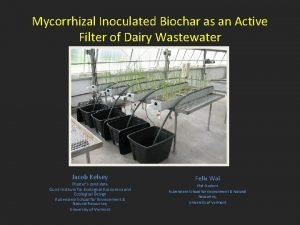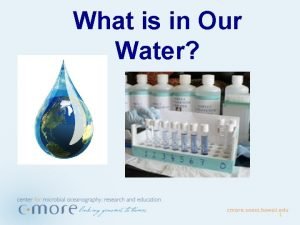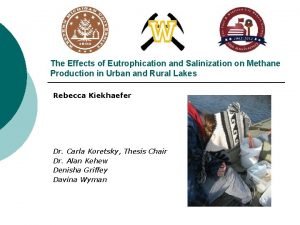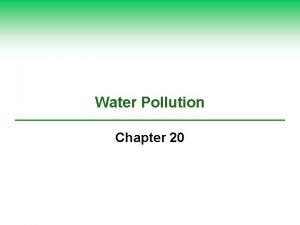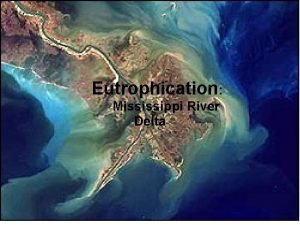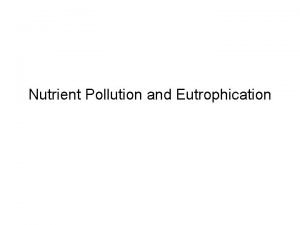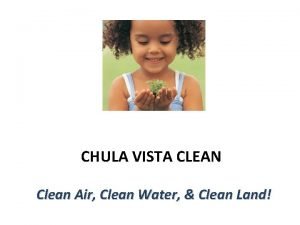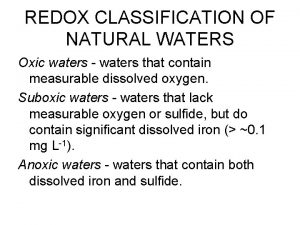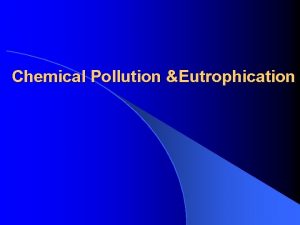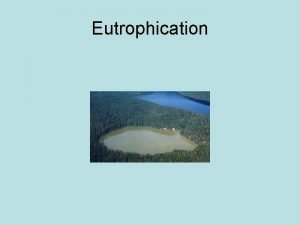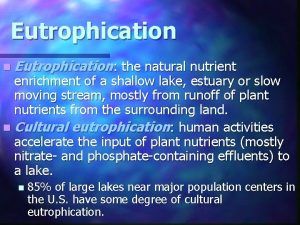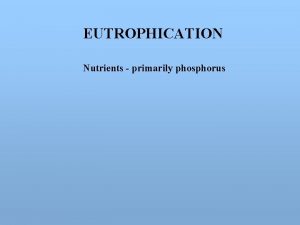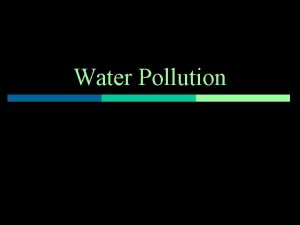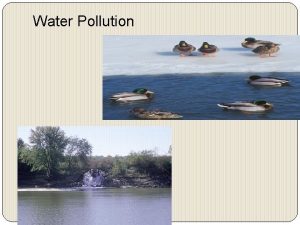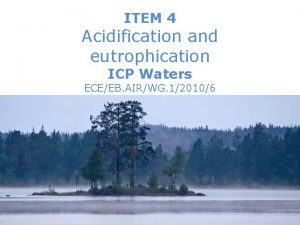Pollution topic 1 Eutrophication Keep the waters clean





















- Slides: 21

Pollution topic 1: Eutrophication Keep the waters clean! Save Barnegat Bay!

Eutrophication • …is an increase in chemical nutrients — compounds containing nitrogen or phosphorus — in an ecosystem, and may occur on land or in water.

Causes: • Eutrophication is frequently a result of nutrient pollution, such as the release of sewage effluent, urban stormwater run-off, and run-off carrying excess fertilizers into natural waters. • However, it may also occur naturally in situations where nutrients accumulate (e. g. depositional environments) or where they flow into systems on an short-term basis.

Human impact: Sources of N and P • Sewage: nitrogen in human and animal feces, phosphorus in soaps and detergents • Fertilizer (lawns, crops, golf courses) runoff contains high levels of both N and P • Agriculture/farming: runoff from animal pens (waste) and crops (fertilizers)

Effects: • Adding these nutrients to the water result in excessive plant/algae growth & decay • The immediate effect of this is an increase in the ecosystem's primary productivity • “Primary productivity” is the production of organic compounds from atmospheric or aquatic carbon dioxide, principally through the process of photosynthesis.

Effects: • However, there are further effects including – lack of oxygen – severe reductions in water quality, fish, and other animal populations. – Increase in undesirable (invasive) species with tolerance. Suffocated fish Barnegat Bay sea nettle Surveys showed that 54% of lakes in Asia are eutrophic; in Europe, 53%; in North America, 48%; in South America, 41%; and in Africa, 28%

Effects: • Water toxicity: eutrophication results in harmful species of phytoplankton and bacteria which make water unsafe to drink or use for recreation • Loss of biodiversity: Under eutrophic conditions, dissolved oxygen greatly increases during the day, but is greatly reduced after dark by the respiring algae and by microorganisms that feed on the increasing mass of dead algae. • When dissolved oxygen levels decline to hypoxic levels, fish and other marine animals suffocate. As a result, creatures such as fish, shrimp, and especially immobile bottom dwellers die off.

Solutions: • Enforce Buffer Zones: farmland community construction far enough away from water bodies to avoid runoff. • Use low-nitrogen, slow-release fertilizers; fertilize less often. http: //www. bbep. org/nps. html • Use phosphorus-free detergents. http: //seattletimes. nwsource. com/html/politics/2002893980_detergent 28 m. html • Legal enforcement: Laws regulating the discharge and treatment of sewage have led to dramatic nutrient reductions to surrounding ecosystems.

Low oxygen levels in Barnegat Bay may spur lawn-fertilizer rules by The Star-Ledger Continuous News Desk Friday November 14, 2008, 6: 01 AM Water sampling stations this summer detected low levels of dissolved oxygen in northern Barnegat Bay and the data could push state and county governments to impose rules on the use of lawn fertilizer in Ocean County, according to a report in the Asbury Park Press. The report said the state Department of Environmental Protection has been slow to impose a round of pollution controls in the bay watershed, because standard legal measures of bay impairment under the law -- like lowdissolved oxygen -- had not shown up in water tests.

View from above Lake 226 divider curtain in August 1973. The bright green color results from blue green algae (Cyanobacteria), which are growing on phosphorus added to the near side of the curtain. ELA Lake 226 was the site of a visually spectacular experiment. The lake was divided into two approximately equal portions using a plastic divider curtain. Carbon and nitrogen were added to one half of the lake, while carbon, nitrogen and phosphorus were added to the other half. For eight consecutive years, the side receiving phosphorus developed eutrophic algal blooms, while the side receiving only carbon and nitrogen did not (see photo, below). However, after only two years, this experiment convinced even the skeptics that phosphorus is the key nutrient. A multi-billion dollar phosphate control program was soon instituted within the St. Lawrence Great Lakes Basin. Legislation to control phosphates in sewage, and to remove phosphates from laundry detergents, was part of this program.

Pollution Topic 2: Biological Magnification

Biological Magnification • also known as bioamplification or “biomagnification”, is the increase in concentration of a substance, such as the pesticide DDT, that occurs in a food chain as a consequence of: – Food chain energetics – Low (or nonexistent) rate of excretion/degradation of the substance. • Although sometimes used interchangeably with 'bioaccumulation, ' an important distinction is drawn between the two, and with bioconcentration. • Bioaccumulation occurs within a trophic level, and is the increase in concentration of a substance in an individuals' tissues due to uptake from food and sediments in an aquatic milieu. • Bioconcentration is defined as occurring when uptake from the water is greater than excretion (Landrum and Fisher, 1999) • Thus bioconcentration and bioaccumulation occur within an organism, and biomagnification occurs across trophic (food chain) levels.

Trophic Levels in an Ecosystem

How substances accumulate: • Lipid soluble (lipophilic) substances cannot be excreted in urine, a water-based medium, and so accumulate in fatty tissues of an organism if the organism lacks enzymes to degrade them. • When eaten by another organism, fats are absorbed in the gut, carrying the substance, which then accumulates in the fats of the predator. • Since at each level of the food chain there is a lot of energy loss, a predator must consume many prey, including all of their lipophilic substances.

A “classic” example: DDT stands for dichloro, diphenyl trichloroethane. It is a chlorinated hydrocarbon, a class of chemicals which often fit the characteristics necessary for biomagnification. DDT has a half-life of 15 years. Was widely used to kill mosquitoes and lice. Rain washed the DDT into creeks, where it eventually found its way into lakes and the ocean. The toxic pollutant bioaccumulated within each organism and then biomagnified through the food web to very high levels in predatory birds such as bald eagles, osprey, peregrine falcons and brown pelicans that ate the fish. Levels of DDT were high enough that the birds' eggshells became abnormally thin. As a result, the adult birds broke the shells of their unhatched offspring and the baby birds died. The population of these birds plummeted. DDT was finally banned in the United States in 1972, and since that time there have been dramatic increases in the populations of many predatory birds. Credit for sounding the warning about DDT and biomagnification usually goes to the scientist Rachel Carson, who wrote the influential book Silent Spring (1962). The silent spring alluded to in the title describes a world in which all the songbirds have been poisoned.

An example: • For example, though mercury is only present in small amounts in seawater, it is absorbed by algae (generally as methylmercury). It is efficiently absorbed, but only very slowly excreted by organisms (Croteau et al, 2005). • Bioaccumulation and biomagnification result in buildup in the adipose tissue of successive trophic levels: zooplankton, small nekton, larger fish etc. • Anything which eats these fish also consumes the higher level of mercury the fish have accumulated. • This process explains why predatory fish such as swordfish and sharks or birds like osprey and eagles have higher concentrations of mercury in their tissue than could be accounted for by direct exposure alone. • For example, herring contains mercury at approximately 0. 01 ppm and shark contains mercury at greater than 1 ppm (EPA 1997).


Causes: Novel organic substances • DDT • PCBs • Toxaphene • Monomethylmercury Inorganic substances • Arsenic • Cadmium • Mercury

Examples of Products that contain Pollutants that Bioaccumulate: • • • Pesticides Herbicides Batteries Fluorescent light bulbs Computers and many electronic devices

Solutions: • The success of top predatory-bird recovery (bald eagles, peregrine falcons) in North America following the ban on DDT use in agriculture is testament to the importance of biomagnification.

 Major source of water
Major source of water Clean up everybody let's clean up
Clean up everybody let's clean up Keep clean
Keep clean Keep pots clean or family gets sick
Keep pots clean or family gets sick Keep pond clean or froggy gets sick
Keep pond clean or froggy gets sick What do you do to keep your city clean
What do you do to keep your city clean Keep it clean partnership
Keep it clean partnership How did the romans keep clean
How did the romans keep clean Stakeholder mapping exercise
Stakeholder mapping exercise Keep satisfied manage closely monitor keep informed
Keep satisfied manage closely monitor keep informed Keep it secret keep it safe
Keep it secret keep it safe Eutrophication
Eutrophication Phosphorus cycle diagram
Phosphorus cycle diagram Eutrophication
Eutrophication Eutrophication steps
Eutrophication steps Eutrophication
Eutrophication Eutrophication
Eutrophication Bbc bitesize eutrophication
Bbc bitesize eutrophication Eutrophication
Eutrophication Eutrophication
Eutrophication Eutrophication
Eutrophication Paragraph writing strategies
Paragraph writing strategies
